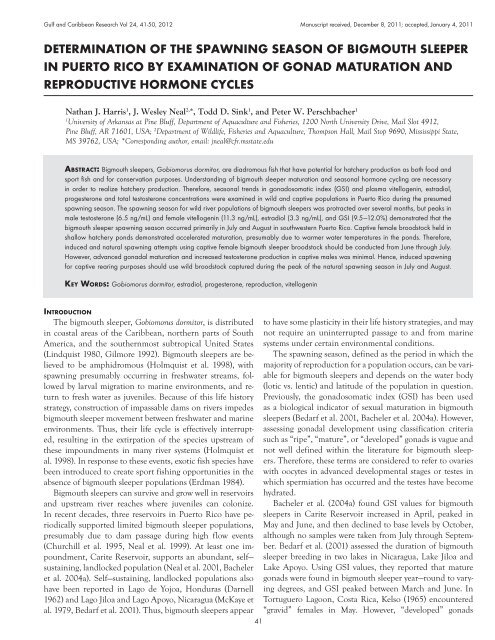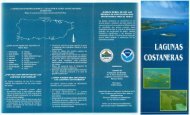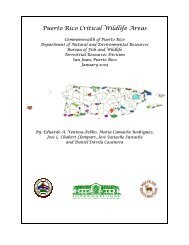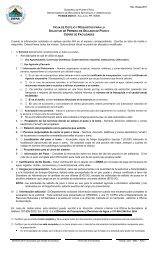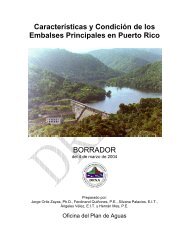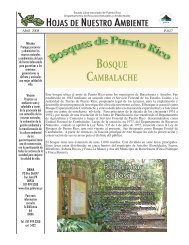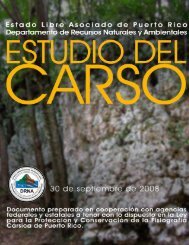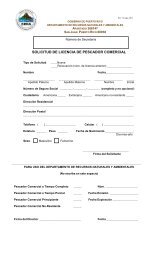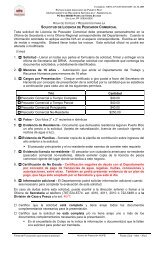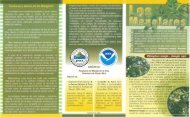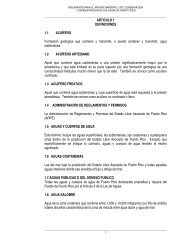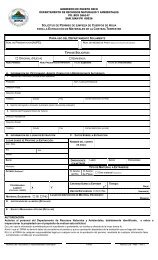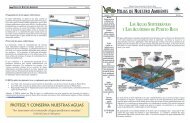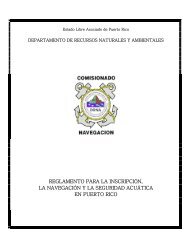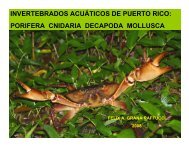determination of the spawning season of bigmouth sleeper
determination of the spawning season of bigmouth sleeper
determination of the spawning season of bigmouth sleeper
Create successful ePaper yourself
Turn your PDF publications into a flip-book with our unique Google optimized e-Paper software.
Gulf and Caribbean Research Vol 24, 41-50, 2012 Manuscript received, December 8, 2011; accepted, January 4, 2011<br />
DETERMINATION OF THE SPAWNING SEASON OF BIGMOUTH SLEEPER<br />
IN PUERTO RICO BY EXAMINATION OF GONAD MATURATION AND<br />
REPRODUCTIVE HORMONE CYCLES<br />
Nathan J. Harris 1 , J. Wesley Neal 2, *, Todd D. Sink 1 , and Peter W. Perschbacher 1<br />
1 University <strong>of</strong> Arkansas at Pine Bluff, Department <strong>of</strong> Aquaculture and Fisheries, 1200 North University Drive, Mail Slot 4912,<br />
Pine Bluff, AR 71601, USA; 2 Department <strong>of</strong> Wildlife, Fisheries and Aquaculture, Thompson Hall, Mail Stop 9690, Mississippi State,<br />
MS 39762, USA; *Corresponding author, email: jneal@cfr.msstate.edu<br />
AbstrAct: Bigmouth <strong>sleeper</strong>s, Gobiomorus dormitor, are diadromous fish that have potential for hatchery production as both food and<br />
sport fish and for conservation purposes. Understanding <strong>of</strong> <strong>bigmouth</strong> <strong>sleeper</strong> maturation and <strong>season</strong>al hormone cycling are necessary<br />
in order to realize hatchery production. Therefore, <strong>season</strong>al trends in gonadosomatic index (GSI) and plasma vitellogenin, estradiol,<br />
progesterone and total testosterone concentrations were examined in wild and captive populations in Puerto Rico during <strong>the</strong> presumed<br />
<strong>spawning</strong> <strong>season</strong>. The <strong>spawning</strong> <strong>season</strong> for wild river populations <strong>of</strong> <strong>bigmouth</strong> <strong>sleeper</strong>s was protracted over several months, but peaks in<br />
male testosterone (6.5 ng/mL) and female vitellogenin (11.3 ng/mL), estradiol (3.3 ng/mL), and GSI (9.5—12.0%) demonstrated that <strong>the</strong><br />
<strong>bigmouth</strong> <strong>sleeper</strong> <strong>spawning</strong> <strong>season</strong> occurred primarily in July and August in southwestern Puerto Rico. Captive female broodstock held in<br />
shallow hatchery ponds demonstrated accelerated maturation, presumably due to warmer water temperatures in <strong>the</strong> ponds. Therefore,<br />
induced and natural <strong>spawning</strong> attempts using captive female <strong>bigmouth</strong> <strong>sleeper</strong> broodstock should be conducted from June through July.<br />
However, advanced gonadal maturation and increased testosterone production in captive males was minimal. Hence, induced <strong>spawning</strong><br />
for captive rearing purposes should use wild broodstock captured during <strong>the</strong> peak <strong>of</strong> <strong>the</strong> natural <strong>spawning</strong> <strong>season</strong> in July and August.<br />
Key words: Gobiomorus dormitor, estradiol, progesterone, reproduction, vitellogenin<br />
IntroductIon<br />
The <strong>bigmouth</strong> <strong>sleeper</strong>, Gobiomorus dormitor, is distributed to have some plasticity in <strong>the</strong>ir life history strategies, and may<br />
in coastal areas <strong>of</strong> <strong>the</strong> Caribbean, nor<strong>the</strong>rn parts <strong>of</strong> South not require an uninterrupted passage to and from marine<br />
America, and <strong>the</strong> sou<strong>the</strong>rnmost subtropical United States systems under certain environmental conditions.<br />
(Lindquist 1980, Gilmore 1992). Bigmouth <strong>sleeper</strong>s are be- The <strong>spawning</strong> <strong>season</strong>, defined as <strong>the</strong> period in which <strong>the</strong><br />
lieved to be amphidromous (Holmquist et al. 1998), with majority <strong>of</strong> reproduction for a population occurs, can be vari-<br />
<strong>spawning</strong> presumably occurring in freshwater streams, folable for <strong>bigmouth</strong> <strong>sleeper</strong>s and depends on <strong>the</strong> water body<br />
lowed by larval migration to marine environments, and re- (lotic vs. lentic) and latitude <strong>of</strong> <strong>the</strong> population in question.<br />
turn to fresh water as juveniles. Because <strong>of</strong> this life history Previously, <strong>the</strong> gonadosomatic index (GSI) has been used<br />
strategy, construction <strong>of</strong> impassable dams on rivers impedes as a biological indicator <strong>of</strong> sexual maturation in <strong>bigmouth</strong><br />
<strong>bigmouth</strong> <strong>sleeper</strong> movement between freshwater and marine <strong>sleeper</strong>s (Bedarf et al. 2001, Bacheler et al. 2004a). However,<br />
environments. Thus, <strong>the</strong>ir life cycle is effectively interrupt- assessing gonadal development using classification criteria<br />
ed, resulting in <strong>the</strong> extirpation <strong>of</strong> <strong>the</strong> species upstream <strong>of</strong> such as “ripe”, “mature”, or “developed” gonads is vague and<br />
<strong>the</strong>se impoundments in many river systems (Holmquist et not well defined within <strong>the</strong> literature for <strong>bigmouth</strong> sleep-<br />
al. 1998). In response to <strong>the</strong>se events, exotic fish species have ers. Therefore, <strong>the</strong>se terms are considered to refer to ovaries<br />
been introduced to create sport fishing opportunities in <strong>the</strong> with oocytes in advanced developmental stages or testes in<br />
absence <strong>of</strong> <strong>bigmouth</strong> <strong>sleeper</strong> populations (Erdman 1984). which spermiation has occurred and <strong>the</strong> testes have become<br />
Bigmouth <strong>sleeper</strong>s can survive and grow well in reservoirs hydrated.<br />
and upstream river reaches where juveniles can colonize. Bacheler et al. (2004a) found GSI values for <strong>bigmouth</strong><br />
In recent decades, three reservoirs in Puerto Rico have pe- <strong>sleeper</strong>s in Carite Reservoir increased in April, peaked in<br />
riodically supported limited <strong>bigmouth</strong> <strong>sleeper</strong> populations, May and June, and <strong>the</strong>n declined to base levels by October,<br />
presumably due to dam passage during high flow events although no samples were taken from July through Septem-<br />
(Churchill et al. 1995, Neal et al. 1999). At least one imber. Bedarf et al. (2001) assessed <strong>the</strong> duration <strong>of</strong> <strong>bigmouth</strong><br />
poundment, Carite Reservoir, supports an abundant, self— <strong>sleeper</strong> breeding in two lakes in Nicaragua, Lake Jiloa and<br />
sustaining, landlocked population (Neal et al. 2001, Bacheler Lake Apoyo. Using GSI values, <strong>the</strong>y reported that mature<br />
et al. 2004a). Self—sustaining, landlocked populations also gonads were found in <strong>bigmouth</strong> <strong>sleeper</strong> year—round to vary-<br />
have been reported in Lago de Yojoa, Honduras (Darnell ing degrees, and GSI peaked between March and June. In<br />
1962) and Lago Jiloa and Lago Apoyo, Nicaragua (McKaye et Tortuguero Lagoon, Costa Rica, Kelso (1965) encountered<br />
al. 1979, Bedarf et al. 2001). Thus, <strong>bigmouth</strong> <strong>sleeper</strong>s appear<br />
41<br />
“gravid” females in May. However, “developed” gonads
were reported from March to December in ano<strong>the</strong>r Costa<br />
Rica study (Winemiller and Ponwith 1998), and from April<br />
through November in Tecolutla estuary in Veracruz, Mexico<br />
(Hernández—Saavedra et al. 2004). Collectively, <strong>the</strong>se findings<br />
suggest near year—round or extended <strong>spawning</strong> periods<br />
in some <strong>bigmouth</strong> <strong>sleeper</strong> populations.<br />
In addition to examination <strong>of</strong> GSI values, plasma or serum<br />
sex steroid concentrations also can be effective in assessing<br />
reproductive development. Hormones such as 17β—estradiol<br />
(estradiol) and testosterone have been used to assess<br />
reproductive development in multiple fish species (Zohar<br />
and Billard 1984, Foster et al. 1993, Holcombe et al. 2000,<br />
Davis et al. 2005, Gross et al. 2006), including members <strong>of</strong><br />
<strong>the</strong> family Eleotridae (Wang et al. 2001). Vitellogenin has<br />
been effective for determining onset <strong>of</strong> sexual maturation<br />
and its continued development in female teleosts, specifically<br />
by using an enzyme—linked immunosorbent assay (ELISA)<br />
(Jackson and Sullivan 1995, Heppell et al. 1999, Gross et al.<br />
2006). Progesterone also has been used with some success to<br />
indicate reproductive maturation in fish (Kagawa et al. 1981,<br />
Nagahama et al. 1991, Foster et al. 1993, Gross et al. 2006).<br />
Evidence <strong>of</strong> natural reproduction in reservoirs, recent<br />
management preferences for native species (Clarkson et al.<br />
2005), and <strong>the</strong> fact that anglers currently target <strong>bigmouth</strong><br />
<strong>sleeper</strong>s for sport and food (Bacheler et al. 2004b) suggest<br />
high potential for this species to serve both sport and food<br />
interests in Puerto Rico and elsewhere. Likewise, declines in<br />
<strong>bigmouth</strong> <strong>sleeper</strong> abundance within its range (Holmquist et<br />
al. 1998, Warren et al. 2000) warrant directed conservation<br />
efforts for this species. If appropriate hatchery propagation<br />
techniques can be developed, supplemental and restoration<br />
stocking could become a viable fisheries management and<br />
conservation tool for <strong>bigmouth</strong> <strong>sleeper</strong>s. However, <strong>spawning</strong><br />
attempts using captive and wild—caught <strong>bigmouth</strong> <strong>sleeper</strong>s<br />
in Puerto Rico have demonstrated minimal success. At<br />
present, <strong>the</strong> major obstacle preventing <strong>the</strong> development <strong>of</strong><br />
appropriate <strong>bigmouth</strong> <strong>sleeper</strong> <strong>spawning</strong> protocols is <strong>the</strong> apparent<br />
lack <strong>of</strong> <strong>season</strong>al reproductive development in captive<br />
specimens <strong>of</strong> reported breeding size (Harris 2007). Thus, to<br />
improve <strong>bigmouth</strong> <strong>sleeper</strong> <strong>spawning</strong> techniques, this study<br />
examined reproductive hormone cycling and reproductive<br />
development for both wild river populations and captive<br />
pond populations in Puerto Rico. This information will be<br />
used to ascertain <strong>the</strong> peak times at which induced <strong>spawning</strong><br />
should be attempted.<br />
MAterIAls And Methods<br />
Study area and fish collections<br />
Three free—flowing rivers in Puerto Rico without significant<br />
instream barriers to fish migration were used as sources<br />
for wild <strong>bigmouth</strong> <strong>sleeper</strong> (Figure 1, Table 1). The Rosario<br />
River, nor<strong>the</strong>ast <strong>of</strong> <strong>the</strong> city <strong>of</strong> Hormigueros, and <strong>the</strong> Nueve<br />
Pasos River, northwest <strong>of</strong> <strong>the</strong> city <strong>of</strong> San Germán, flow into<br />
Harris et al.<br />
<strong>the</strong> Guanajibo River before draining into <strong>the</strong> Mona Passage<br />
south <strong>of</strong> <strong>the</strong> city <strong>of</strong> Mayagüez. The Cañas River drains into<br />
<strong>the</strong> Caribbean Sea on <strong>the</strong> south central portion <strong>of</strong> <strong>the</strong> island<br />
near <strong>the</strong> city <strong>of</strong> Ponce. Fish were collected using a backpack<br />
electr<strong>of</strong>ishing unit using up to 400 volts DC and a 60—Hz<br />
pulse cycle. Due to <strong>the</strong> close proximity, similar physiochemical<br />
and habitat characteristics, and stable tropical water temperatures<br />
(e.g., summer temperatures 24.8—25.9°C; Kwak et<br />
al. 2007) <strong>of</strong> <strong>the</strong>se rivers, <strong>the</strong>y were considered as one sample<br />
population for this manuscript. The amphidromous life history<br />
<strong>of</strong> <strong>bigmouth</strong> <strong>sleeper</strong>s (Holmquist et al. 1998), proximity<br />
<strong>of</strong> <strong>the</strong>se river systems, absence <strong>of</strong> significant in stream barriers<br />
to fish migration, and similar physical and water quality<br />
characteristics <strong>of</strong> <strong>the</strong>se river systems, suggests that population<br />
mixing among <strong>the</strong>se rivers systems is likely to occur.<br />
Captive <strong>bigmouth</strong> <strong>sleeper</strong>s were originally collected at<br />
least one year prior to this study from <strong>the</strong> Cañas, Rosario,<br />
and Nueve Pasos Rivers, and from Carite Reservoir. These<br />
fish were transported to <strong>the</strong> Agricultural Research Station <strong>of</strong><br />
<strong>the</strong> University <strong>of</strong> Puerto Rico—Mayagüez located near Lajas,<br />
Puerto Rico, and held in four 100 m2 ponds with a maximum<br />
depth <strong>of</strong> 1.0 m (summer temperatures 28.1—32.1°C). At least<br />
2 male and 4 female <strong>bigmouth</strong> <strong>sleeper</strong>s were stocked in each<br />
pond. Ponds were stocked with a self—sustaining prey base<br />
<strong>of</strong> mollies Poecilia spp., swordtails Xiphophorus spp., tilapia<br />
Oreochromis and Tilapia spp., and threadfin shad Dorosoma<br />
petenense. Sampling was conducted monthly in conjunction<br />
with sampling <strong>of</strong> wild populations using a standard seine.<br />
Whereas physiological parameters may change with fish size,<br />
<strong>bigmouth</strong> <strong>sleeper</strong> total lengths (TL) were compared using<br />
general linear models (PROC GLM, SAS Version 9.2) with<br />
<strong>the</strong> class variable month, source (wild or hatchery), and sex.<br />
Gonadosomatic index, plasma vitellogenin, and<br />
steroid hormones<br />
Wild <strong>bigmouth</strong> <strong>sleeper</strong> specimens collected from <strong>the</strong><br />
Nueve Pasos, Rosario, and Cañas Rivers between March and<br />
October 2007 were used to determine GSI and hormone<br />
concentrations before, during, and after <strong>the</strong> presumed breeding<br />
<strong>season</strong> (May—June; Bacheler et al. 2004a). Each month,<br />
5—7 females and 3—5 males <strong>of</strong> breeding sizes were collected.<br />
All specimens exceeded <strong>the</strong> reported minimum size at maturity<br />
(159 mm and 179 mm TL for male and female <strong>bigmouth</strong><br />
<strong>sleeper</strong>s, respectively; Bacheler et al. 2004a), and most exceeded<br />
200 mm TL. Fish were measured, weighed (nearest<br />
2.0 g), and euthanized with 150 mg/L <strong>of</strong> tricaine methansulfonate<br />
(MS—222; Argent Chemical Laboratories, Inc.,<br />
Redmond, WA) buffered to pH 7 with sodium bicarbonate.<br />
Blood (1.0—1.5 mL) was taken by insertion <strong>of</strong> a sodium heparin<br />
coated syringe (21 gauge, 38 mm needle) into <strong>the</strong> caudal<br />
vasculature. In cases where blood collection was insufficient,<br />
<strong>the</strong> tail was severed behind <strong>the</strong> posterior dorsal fin and<br />
blood was collected using 470 µL heparinized Caraway tubes.<br />
Blood samples were immediately placed on ice in 1.5 mL<br />
42
Figure 1. Map <strong>of</strong> Puerto Rico showing<br />
rivers sampled in this study.<br />
The rivers (GPS coordinates <strong>of</strong> river<br />
mouth) were:<br />
1) Río Rosario<br />
(18°7’48.76”N, 67°7’59.74”W)<br />
2) Río Nueve Pasos<br />
(18°7’1.47”N, 67°4’27.13”W)<br />
3) Río Cañas<br />
(17°58’53.34”N,66°38’.16.63”W)<br />
Bigmouth <strong>sleeper</strong> reproduction in Puerto Rico<br />
cryotubes coated with ammonium heparin to prevent clotting.<br />
Fish specimens were <strong>the</strong>n dissected to remove testis or<br />
ovaries, weighed, and GSI calculated according to <strong>the</strong> equation:<br />
GSI = (gonad weight/body weight) × 100, and is expressed<br />
as percent body weight (Murphy and Willis 1996).<br />
Due to limitations <strong>of</strong> <strong>the</strong> electronic field balance, all gonads<br />
weighing less than 2 g resulted in a GSI <strong>of</strong> less than 0.4, <strong>the</strong><br />
minimum calculated GSI threshold. Sample collection from<br />
captive <strong>bigmouth</strong> <strong>sleeper</strong>s held in 100 m<br />
43<br />
2 Bergen, Norway) concentrations. An ELISA kit was also<br />
used for <strong>the</strong> qualitative <strong>determination</strong> <strong>of</strong> total testosterone<br />
(Assay Designs, Ann Arbor, MI), though no validation procedures<br />
were conducted due to monetary constraints. Males<br />
were tested for total plasma testosterone concentrations only,<br />
while females were tested for plasma estradiol, progesterone,<br />
and vitellogenin concentrations.<br />
Vitellogenin and hormone assays<br />
ponds at <strong>the</strong> Uni- Each assay was conducted as per <strong>the</strong> instructions provided<br />
versity <strong>of</strong> Puerto Rico – Mayagüez’s Aquaculture Research with <strong>the</strong> kits except for <strong>the</strong> vitellogenin assay. The vitello-<br />
Station was repeated as described above for 3—4 male and genin ELISA kit (V01003402) was specific for detection <strong>of</strong><br />
3—4 females from March through July. No samples were tak- carp Cyprinus carpio vitellogenin, although it has been used<br />
en from captive fish after July because no fish were available. for detection <strong>of</strong> vitellogenin from fa<strong>the</strong>ad minnow Pimephales<br />
Blood samples were centrifuged at <strong>the</strong> laboratory to sepa- promelas, zebrafish Danio rerio, goldfish Carassius auratus, mulrate<br />
<strong>the</strong> plasma. Plasma was transferred into new cryotubes let Mugil sp., pinfish Lagodon rhomboides, sucker Catostomi-<br />
and frozen at —20ºC until transportation on dry ice to <strong>the</strong> dae sp., and o<strong>the</strong>r cyprinids. The monoclonal mouse anti—<br />
University <strong>of</strong> Arkansas at Pine Bluff (UAPB) for determi- carp vitellogenin antibody does not react with vitellogenin<br />
nation <strong>of</strong> vitellogenin and hormone concentrations. The from striped bass Morone saxatilis or brown bullhead Amei-<br />
samples were immediately frozen at –70ºC upon arrival at urus nebulosus (Biosense kit insert). The monoclonal mouse<br />
UAPB. Enzyme—linked immunosorbent assays (ELISA) anti—striped bass vitellogenin antibodies bind vitellogenin<br />
were partially validated for use in <strong>bigmouth</strong> <strong>sleeper</strong>s using from striped bass and rainbow trout Oncorhynchus mykiss,<br />
methods presented in Sink et al. (2008), and <strong>the</strong>n utilized and also cross—reacts with vitellogenin from largemouth<br />
for qualitative <strong>determination</strong> <strong>of</strong> plasma 17β—estradiol (Bio- bass Micropterus salmoides, Atlantic cod Gadus morhua, Nile ti-<br />
Quant, San Diego, CA), progesterone (Assay Designs, Inc., lapia Oreochromis niloticus, mummichog Fundulus heteroclitus,<br />
Ann Arbor, MI), and vitellogenin (Biosense Laboratories, and sheepshead minnow Cyprinodon variegates (Biosense kit
Harris et al.<br />
TABLE 1. Source and sample size <strong>of</strong> <strong>bigmouth</strong> <strong>sleeper</strong>s sampled for GSI, plasma vitellogenin and steroid<br />
hormone concentrations. No fish remained in <strong>the</strong> captive population after <strong>the</strong> July sample.<br />
Number in sample<br />
Wild Captive<br />
Month Male Female Male Female Source population(s) <strong>of</strong> wild fish<br />
March 3 7 4 3 Nueve Pasos River and Rosario River<br />
April 3 5 3 3 Cañas River<br />
May 4 7 3 3 Nueve Pasos River<br />
June 3 5 4 4 Rosario River<br />
July 3 5 4 3 Cañas River<br />
August 5 5 — — Nueve Pasos River<br />
September 5 6 — — Nueve Pasos River<br />
October 5 5 — — Nueve Pasos River<br />
Totals 31 45 18 16<br />
insert). To ensure <strong>the</strong> greatest probability that vitellogenin<br />
from <strong>bigmouth</strong> <strong>sleeper</strong>s was bound during <strong>the</strong> assay, monoclonal<br />
mouse anti—striped bass vitellogenin antibodies were<br />
diluted 1:100 with phosphate buffered saline and 10 µL <strong>of</strong><br />
<strong>the</strong> antibody solution was added to each well <strong>of</strong> <strong>the</strong> microplates<br />
coated with monoclonal mouse anti—carp vitellogenin<br />
antibody. The aqueous solution that contained <strong>the</strong> antibodies<br />
was <strong>the</strong>n evaporated under a gentle stream <strong>of</strong> nitrogen.<br />
The assay was <strong>the</strong>n run using carp and rainbow trout<br />
(V01004301—001) vitellogenin standards and pooled <strong>bigmouth</strong><br />
<strong>sleeper</strong> controls. The greatest <strong>bigmouth</strong> <strong>sleeper</strong> vitellogenin<br />
binding affinity occurred when compared to <strong>the</strong><br />
carp vitellogenin standard. Since <strong>the</strong> carp vitellogenin assay<br />
is not known to detect rainbow trout vitellogenin, does not<br />
bind striped bass vitellogenin, and <strong>the</strong>re is a high probability<br />
that a portion <strong>of</strong> <strong>the</strong> monoclonal mouse anti—striped bass<br />
vitellogenin antibodies were removed during <strong>the</strong> washing<br />
phase, only <strong>the</strong> unaltered carp vitellogenin ELISA was used<br />
for <strong>determination</strong> <strong>of</strong> vitellogenin concentrations from <strong>bigmouth</strong><br />
<strong>sleeper</strong>s during <strong>the</strong> study.<br />
Because hormone trends were <strong>of</strong> interest, and not absolute<br />
concentrations, only partial validations were conducted<br />
for <strong>the</strong> vitellogenin, estradiol, and progesterone assays to<br />
determine <strong>the</strong> suitability <strong>of</strong> <strong>the</strong> kits for detecting hormonal<br />
shifts in <strong>bigmouth</strong> <strong>sleeper</strong>s. The samples were thawed and<br />
150 µL <strong>of</strong> plasma from 3 males were pooled and used for <strong>the</strong><br />
male standard and 5 females were pooled and used for <strong>the</strong><br />
female standard to validate each kit. All samples were run in<br />
duplicate for <strong>the</strong> validation procedures and sample hormone<br />
<strong>determination</strong>. Validation tests followed <strong>the</strong> Validation <strong>of</strong><br />
Analytical Procedures: Methodology (FDA CVM 1999) and<br />
were similar to validation tests used in Barry et al. (1993) for<br />
a cortisol ELISA. Accuracy was tested by calculation <strong>of</strong> recoveries<br />
from samples spiked with known amounts <strong>of</strong> hormones<br />
(3 increments <strong>of</strong> <strong>the</strong> hormone standards provided with <strong>the</strong><br />
kits). Precision was tested by repeated assays <strong>of</strong> samples (8<br />
times in duplicate) on <strong>the</strong> same plate and by calculation <strong>of</strong><br />
44<br />
coefficient <strong>of</strong> variation (%<br />
CV). Mean sample recovery<br />
percentage limits <strong>of</strong> within<br />
90—110% were defined as<br />
meeting validation criteria.<br />
A percent coefficient <strong>of</strong><br />
variation <strong>of</strong> ≤ 20.0 was set as<br />
<strong>the</strong> acceptable limit for <strong>the</strong><br />
intra—assay % CV.<br />
Statistical analyses<br />
Plasma vitellogenin, steroid<br />
hormone concentrations,<br />
and GSI values were<br />
plotted over time to illustrate<br />
monthly trends in reproductive<br />
development,<br />
and to examine relationships<br />
between gonad maturation and hormone levels. To<br />
determine significant monthly trends, one—way analysis <strong>of</strong><br />
variance (ANOVA) was used unless data failed normality,<br />
in which case Kruskal—Wallis non—parametric test <strong>of</strong> ranks<br />
was employed. In ei<strong>the</strong>r test, month served as <strong>the</strong> main effect.<br />
The Kolmogorov—Smirnov test (with Lilliefors’ correction)<br />
was used to test data for normality. Pair—wise multiple<br />
comparisons were used to separate months. Differences in<br />
GSI, hormone and vitellogenin concentrations <strong>of</strong> wild and<br />
captive populations were analyzed using a Student’s t—test<br />
conducted by month. In cases where normality tests failed,<br />
analyses were conducted using a Mann—Whitney Rank Sum<br />
Test. These tests were chosen over paired data tests because<br />
periodicity <strong>of</strong> peaks was <strong>of</strong> interest, and may not have been<br />
discerned by a paired—t test or ANOVA on repeated measures.<br />
A Pearson product—moment correlation coefficient<br />
was used to analyze correlation <strong>of</strong> hormones and GSI for<br />
individual fish. Data for GSI were transformed by taking<br />
ArcSine <strong>of</strong> <strong>the</strong> square root as per Osborne (2002). Statistical<br />
significance for all tests was set at an alpha level <strong>of</strong> 0.05 (Zar<br />
1999).<br />
results<br />
Fish characteristics<br />
A total <strong>of</strong> 57 wild female <strong>bigmouth</strong> <strong>sleeper</strong>s and 31 wild<br />
male <strong>bigmouth</strong> <strong>sleeper</strong>s were collected for this study. Mean ±<br />
se size <strong>of</strong> wild—caught females was 226 ± 3 mm TL and 100<br />
± 4 g.; wild—caught males averaged 271 ± 10 mm TL and 185<br />
± 23 g in size. Sixteen captive females and 18 captive males<br />
were sacrificed for this research. Captive females averaged<br />
253 ± 11 mm TL and 134 ± 16 g, and captive males averaged<br />
270 ± 13 mm TL and 156 ± 22 g. The general linear model<br />
indicated that differences in fish TL occurred (Overall model:<br />
F 12, 51 = 5.71, p < 0.0001, r 2 = 0.57), with month (F 3 = 6.02,<br />
p = 0.0014, r 2 = 0.10) and sex (F 1 = 20.84, p < 0.0001, r 2 =<br />
0.34) contributing to <strong>the</strong> observed variability. Total length
Bigmouth <strong>sleeper</strong> reproduction in Puerto Rico<br />
did not differ significantly between wild versus hatchery fish<br />
(F = 3.03, p = 0.0880, r 1<br />
45<br />
2 individual values reached peaks in May through September<br />
<strong>of</strong> 9.5—12.0. Conversely, captive females had greater GSI values<br />
in March than wild females, which moderately increased<br />
in April and May before peaking in June, <strong>the</strong>n dropped to<br />
nearly half <strong>the</strong> peak value in <strong>the</strong> final samples <strong>of</strong> captive fish<br />
in July (Figure 2). However, this trend was not statistically<br />
significant (F = 1.837, p = 0.192). Minimum individual val-<br />
4,11<br />
ues <strong>of</strong> captive fish in every month were below <strong>the</strong> minimum<br />
calculated GSI threshold <strong>of</strong> 0.4, and maximum individual<br />
values peaked at nearly 6.0 for May and June. Monthly comparisons<br />
<strong>of</strong> wild—caught versus captive females found only<br />
one significant difference in GSI that occurred during July<br />
(t = 2.58, p = 0.042; Table 2).<br />
6<br />
Wild—caught males had baseline GSI values below <strong>the</strong><br />
minimum calculated GSI threshold <strong>of</strong> 0.4 for both March<br />
and April samples, followed by slight increases from May<br />
through June, peaking in July before decreasing to baseline<br />
values again in August (F = 16.94, p < 0.001; Figure 3). A<br />
7,23<br />
slight increase <strong>of</strong> GSI values was observed in September with<br />
a final decrease in gonadal development in October. Minimum<br />
individual values were below <strong>the</strong> minimum calculated<br />
GSI threshold <strong>of</strong> 0.4 for every month. Peak measurements<br />
for individuals were observed in June and July at 2.0 and 2.7,<br />
respectively. Captive males showed no discernable gonad development<br />
throughout <strong>the</strong> study, and no significant difference<br />
between wild and captive male GSI was found in any<br />
month, although differences approached significant levels in<br />
March, June, and July (Table 2).<br />
Vitellogenin<br />
The ability <strong>of</strong> <strong>the</strong> carp vitellogenin kit to accurately detect<br />
<strong>bigmouth</strong> <strong>sleeper</strong> vitellogenin was low in <strong>the</strong> range <strong>of</strong><br />
samples tested (mean recovery <strong>of</strong> samples spiked with 5, 10,<br />
Figure 2. Comparison <strong>of</strong> gonadosomatic index (GSI), plasma vitellogenin<br />
and steroid hormone concentrations in female <strong>bigmouth</strong> <strong>sleeper</strong>s from or 15 ng/mL = 84.4%). The precision <strong>of</strong> sample detection<br />
wild—caught (solid bars) and captive (open bars) populations. GSI (go- and ability to reproduce results from <strong>the</strong> same sample were<br />
nad weight/body weight x 100), vitellogenin (ng/mL), estradiol (ng/mL), within <strong>the</strong> established limits (%CV < 20%) for <strong>the</strong> validation<br />
and progesterone (ng/mL) are presented. Progesterone was not measured (mean inter—assay %CV = 18.9%; mean intra—assay %CV =<br />
in wild—caught fish in September and October. No captive fish remained<br />
11.3%; range 2.3—25.8%).<br />
after July samples. Error bars represent standard errors (se). The p—values<br />
reflect analysis <strong>of</strong> variance among months for each population, with Plasma samples from wild—caught female <strong>bigmouth</strong> sleep-<br />
pair—wise comparisons indicated with lowercase letters. Individual months er contained no detectable vitellogenin concentrations in<br />
that differed between wild—caught and captive fish are indicated with an March, followed by a steady increase in mean vitellogenin<br />
asterisk (*).<br />
from April through June before peaking in July (Figure 2).<br />
Vitellogenin concentrations decreased from August to near<br />
initial concentrations by October. Minimum individual female<br />
vitellogenin concentrations were 0.0 for every month,<br />
= 0.04).<br />
and maximum concentrations for individual females reached<br />
GSI<br />
10.4, 11.3, and 17.0 ng/mL for July, August and September,<br />
Wild—caught females showed clear temporal trends in<br />
respectively. There was no apparent relationship between<br />
GSI during spring and summer (F = 6.36, p < 0.001).<br />
7,37 fish size and maximum vitellogenin measurements. Statisti-<br />
Values for GSI were below <strong>the</strong> minimum calculated GSI<br />
cal analysis did not indicate differences between months for<br />
threshold <strong>of</strong> 0.4 in March samples, but increased from April<br />
vitellogenin (F = 2.05, p = 0.100) despite an obvious trend<br />
through June, and peaked in July before declining in Au-<br />
5,26<br />
graphically. This anomaly was likely <strong>the</strong> result <strong>of</strong> <strong>the</strong> low samgust<br />
and September to baseline levels in October (Figure 2).<br />
ple sizes in conjunction with <strong>the</strong> high variability in <strong>the</strong> data.<br />
Minimum individual values for each month were below <strong>the</strong><br />
Plasma samples from captive females contained greater<br />
minimum calculated GSI threshold <strong>of</strong> 0.4, and maximum
concentrations <strong>of</strong> vitellogenin<br />
in March compared to<br />
wild fish, maintaining averages<br />
just below 1.0 ng/mL every<br />
month until June, when<br />
it peaked before dropping to<br />
0.0 in July (Figure 2). Minimum<br />
individual female vitellogenin<br />
concentrations were<br />
0.0 for every month except<br />
June, which had a minimum<br />
sample concentration <strong>of</strong> 1.4<br />
ng/mL. Maximum concentrations<br />
for individual females<br />
ranged from 1.7 to 3.7<br />
ng/mL from March through<br />
June. Monthly comparisons<br />
suggested no significant differences<br />
in vitellogenin concentrations<br />
between wild<br />
and captive populations (Table 2). However, wild—caught<br />
<strong>bigmouth</strong> <strong>sleeper</strong> in July had much greater concentrations<br />
than captive fish, and approached statistical significance (t 6<br />
= —2.35, p = 0.057).<br />
Estradiol<br />
The ability <strong>of</strong> <strong>the</strong> estradiol kit to accurately detect <strong>bigmouth</strong><br />
<strong>sleeper</strong> estradiol was acceptable in <strong>the</strong> range <strong>of</strong> samples<br />
tested (mean recovery <strong>of</strong> samples spiked with 1, 3, or<br />
10 ng/mL = 90.0%). However, <strong>the</strong> precision and ability to<br />
reproduce results from <strong>the</strong> same sample did not fall within<br />
<strong>the</strong> established limits (%CV < 20%) for <strong>the</strong> validation (mean<br />
inter—assay %CV = 21.7%; mean intra—assay %CV = 16.8%,<br />
range 6.4—22.8%).<br />
Plasma samples from wild—caught females contained low<br />
concentrations <strong>of</strong> estradiol in March and exhibited a slight<br />
increase in April (Figure 2). This trend was followed by a<br />
decline in plasma estradiol concentrations in May before<br />
concentrations peaked in July (Figure 2). Ano<strong>the</strong>r decline<br />
in estradiol concentrations began in August, which led to<br />
low concentrations in September and October. Minimum<br />
individual estradiol concentrations never dropped below<br />
0.05 ng/mL, which was found in October. Maximum readings<br />
for individual fish were 3.5 and 3.3 ng/mL, respectively;<br />
minimum and maximum values were recorded in April and<br />
July, respectively.<br />
Captive female <strong>bigmouth</strong> <strong>sleeper</strong> contained greater plasma<br />
estradiol concentrations in March than wild fish, and<br />
exhibited a decline in concentrations through April and<br />
May before increasing in June and peaking in July (Figure<br />
2). The minimum individual plasma estradiol concentration<br />
was 0.3 ng/mL from a female sampled in May. Maximum<br />
plasma estradiol concentrations for individual fish were 1.8<br />
and 1.9 ng/mL for March and June, respectively. Monthly<br />
Harris et al.<br />
TABLE 2. Statistical results for comparisons <strong>of</strong> reproductive development indicators between wild and captive<br />
<strong>bigmouth</strong> <strong>sleeper</strong> populations. Test statistic (T) represents a Mann—Whitney Rank Sum Test used when normality<br />
or equal variance tests failed. A Student’s t—test statistic (t) was used when normality and equal variance<br />
tests passed. Bold type indicates statistical significance at alpha level <strong>of</strong> 0.05. There were no captive fish<br />
remaining after July, so fur<strong>the</strong>r comparisons were not possible.<br />
Month Female Male Vitellogenin Estradiol Progesterone Testosterone<br />
GSI GSI<br />
March T = 20.000 T = 18.000 T = 18.500 t = 1.500 T = 11.000 t = 3.742<br />
p = 0.517 p = 0.057 p = 0.143 p = 0.133 p = 0.133 p = 0.013<br />
April T = 14.000 T = 6.000 T = 14.000 t = 1.309 t = 0.953 t = 0.267<br />
p = 1.000 p = 0.100 p = 1.000 p = 0.238 p = 0.384 p = 0.802<br />
May t = 1.267 T = 7.500 t = 1.166 t = 1.511 T = 24.000 t = 0.260<br />
p = 0.241 p = 0.114 p = 0.277 p = 0.169 p = 0.117 p = 0.808<br />
June t = 0.582 T = 18.000 t = 0.309 t = 0.106 t = 0.550 t = 1.025<br />
p = 0.579 p = 0.057 p = 0.768 p = 0.919 p = 0.611 p = 0.363<br />
July t = 2.584 T = 18.000 t = 2.351 t = 1.425 —— t = 4.033<br />
p = 0.042 p = 0.057 p = 0.204 p = 0.204 p = 0.010<br />
46<br />
comparisons between wild and captive populations found no<br />
significant differences in estradiol concentrations (p > 0.05)<br />
(Table 2).<br />
Progesterone<br />
The ability <strong>of</strong> <strong>the</strong> progesterone kit to accurately detect <strong>bigmouth</strong><br />
<strong>sleeper</strong> progesterone was acceptable (mean recovery<br />
<strong>of</strong> samples spiked with 1, 5, or 10 ng/mL = 94.4%). The precision<br />
and ability to reproduce results from <strong>the</strong> same sample<br />
was within <strong>the</strong> established limits for <strong>the</strong> validation (mean<br />
inter—assay %CV = 12.9%; mean intra—assay %CV = 9.8%,<br />
range 1.2—13.7%).<br />
Wild—caught female <strong>bigmouth</strong> <strong>sleeper</strong> showed no discernible<br />
trends in plasma progesterone concentrations, averaging<br />
between 0.2 and 0.3 ng/mL throughout <strong>the</strong> study (Figure 2).<br />
The minimum and maximum progesterone concentrations<br />
for individual <strong>bigmouth</strong> <strong>sleeper</strong> were 0.1 and 0.5 ng/mL,<br />
respectively. Both minimum and maximum values were recorded<br />
in August. Captive female <strong>bigmouth</strong> <strong>sleeper</strong> showed<br />
slightly more variation in progesterone concentrations, ranging<br />
from 0.3 to 0.6 ng/mL, with a steady decline from March<br />
to July, though <strong>the</strong> trend was not statistically significant (H 4<br />
= 8.31, p = 0.081) (Figure 2). The minimum and maximum<br />
plasma progesterone concentrations for individual captive<br />
fish were 0.2 and 0.7 ng/mL, respectively; minimum and<br />
maximum values were recorded in June and March, respectively.<br />
Monthly comparisons <strong>of</strong> wild and captive populations<br />
found no significant differences in progesterone concentrations<br />
(Table 2). Due to no discernable trends in progesterone<br />
data, no testing was conducted for progesterone in September<br />
and October.<br />
Testosterone<br />
Plasma testosterone concentrations (mean intra—assay<br />
%CV = 8.4%, range 0.6—14.2%) in wild—caught male big-
mouth <strong>sleeper</strong> steadily increased from March to June before<br />
increasing rapidly in July (Figure 3). Mean testosterone<br />
concentrations peaked in August and September before declining<br />
in October. Minimum and maximum testosterone<br />
concentrations for individual fish were 0.3 and 6.5 ng/mL,<br />
respectively; minimum and maximum values were recorded<br />
in March and August, respectively.<br />
Captive male <strong>bigmouth</strong> <strong>sleeper</strong> showed little variation in<br />
plasma testosterone concentrations for <strong>the</strong> duration <strong>of</strong> <strong>the</strong><br />
study, with monthly averages ranging from 0.6 to 0.8 ng/mL.<br />
Minimum and maximum values for individual fish were 0.3<br />
and 0.9 ng/mL, respectively; minimum and maximum values<br />
were recorded in April and March, respectively. Comparisons<br />
<strong>of</strong> testosterone concentrations in wild—caught versus<br />
captive <strong>bigmouth</strong> <strong>sleeper</strong> indicated significant differences in<br />
both March and July (Table 2). In March, <strong>the</strong> average testosterone<br />
concentration for captive fish was twice that <strong>of</strong> wild<br />
fish (t 5 = 3.74, p = 0.013). In July, testosterone concentrations<br />
in wild fish peaked and averaged more than four times that<br />
<strong>of</strong> captive male testosterone concentrations (t 5 = —4.03, p =<br />
0.010).<br />
Pearson product—moment correlation coefficient<br />
For wild—caught <strong>bigmouth</strong> <strong>sleeper</strong>, significant positive<br />
correlations over time were detected between female GSI and<br />
vitellogenin (r = 0.90, p < 0.001) and estradiol (r = 0.47, p <<br />
0.001), but not for progesterone (r = —0.24, p = 0.151). Vitellogenin<br />
production was positively correlated with estradiol<br />
concentration (r = 0.28, p = 0.033), but not progesterone<br />
concentration (r = —0.25, p = 0.123). Estradiol concentration<br />
was not correlated with progesterone concentration (r =<br />
—0.13, p = 0.445).<br />
dIscussIon<br />
Seasonal trends in GSI and plasma vitellogenin, estradiol,<br />
and total testosterone concentrations indicated that <strong>the</strong><br />
<strong>spawning</strong> <strong>season</strong> <strong>of</strong> <strong>bigmouth</strong> <strong>sleeper</strong>s is protracted over several<br />
months, but occurs primarily in July and August in wild<br />
river populations <strong>of</strong> southwestern Puerto Rico. For female<br />
<strong>bigmouth</strong> <strong>sleeper</strong>s, vitellogenin concentrations and GSI values<br />
peaked in July, while estradiol concentrations showed a<br />
bimodal distribution. Estradiol peaked in April and again<br />
in July coincident with <strong>the</strong> peak <strong>of</strong> GSI values. The bimodal<br />
pattern <strong>of</strong> estradiol secretion found in this study corresponded<br />
to an initial increase prior to vitellogenesis and gonadal<br />
development (as indicated by GSI) and a second increase prior<br />
to presumed <strong>spawning</strong>. This bimodal pattern <strong>of</strong> estradiol<br />
secretion has been documented in o<strong>the</strong>r fish species (Jackson<br />
and Sullivan 1995). The correlation between estradiol,<br />
vitellogenin, and GSI were anticipated with ovarian development<br />
preceding <strong>spawning</strong>, and is attributed to vitellogenesis<br />
induced by secretion <strong>of</strong> estrogen. The secretion <strong>of</strong> estradiol<br />
during ovarian development stimulates vitellogenin syn<strong>the</strong>sis<br />
in <strong>the</strong> liver. Vitellogenins are integrated into developing<br />
Bigmouth <strong>sleeper</strong> reproduction in Puerto Rico<br />
47<br />
eggs as phosvitin and lipovitellin, resulting in increased ovarian<br />
size and GSI (Davis et al. 2005). Data from this study<br />
similarly indicate <strong>the</strong> same progression with an increase in<br />
estradiol secretion followed by simultaneous increases in vitellogenin<br />
production and GSI.<br />
The lack <strong>of</strong> any noticeable increase in production <strong>of</strong> total<br />
progesterone during this study was enigmatic, as Zohar<br />
and Billard (1984) reported several periods <strong>of</strong> increased progesterone—derived<br />
17α—hydroxy—20β—dihydroprogesterone<br />
during <strong>the</strong> maturation cycles <strong>of</strong> fish. While <strong>the</strong> assay kit used<br />
to detect progesterone was only 3.46% cross—reactive with<br />
17α—hydroxy—20β—dihydroprogesterone, increased progesterone<br />
secretion would be likely in response to elevated<br />
17α—hydroxy—20β—dihydroprogesterone, as it is <strong>the</strong> primary<br />
precursor to this hormone. However, no such increases in<br />
progesterone production were noted in this study. Perhaps<br />
although concentrations <strong>of</strong> 17α—hydroxy—20β—dihydroprogesterone<br />
undergo several changes during fish gonad matura-<br />
Figure 3. Comparison <strong>of</strong> gonadosomatic index (Top; GSI = gonad<br />
weight/body weight x 100) and plasma testosterone concentrations (Bottom)<br />
in wild—caught and captive male <strong>bigmouth</strong> <strong>sleeper</strong>s. Error bars represent<br />
standard errors (se). The p—values reflect analysis <strong>of</strong> variance among<br />
months for each population, with pair—wise comparisons indicated with<br />
lowercase letters. Individual months that differed between wild—caught and<br />
captive fish are indicated with an asterisk (*).
tion, concentrations <strong>of</strong> its precursor progesterone remain relatively<br />
unchanged in <strong>bigmouth</strong> <strong>sleeper</strong>s. Significant increases<br />
in progesterone concentrations just prior to final maturation<br />
may have been missed, as we were unable to collect any females<br />
that were in <strong>the</strong> final stages <strong>of</strong> maturation or about to<br />
undergo ovulation. 17α—hydroxy—20β—dihydroprogesterone<br />
is <strong>of</strong>ten only apparent for short durations during maturation<br />
and easily could have been missed. Very little is known<br />
about maturation or hormone cycling in <strong>bigmouth</strong> <strong>sleeper</strong>s,<br />
so it may be possible that progesterone is not a maturation<br />
hormone in this species.<br />
Wild male <strong>bigmouth</strong> <strong>sleeper</strong> GSI peaked in July and<br />
dropped to below <strong>the</strong> minimum calculated GSI threshold<br />
<strong>of</strong> 0.4 in August, but testosterone concentrations continued<br />
to increase in August before gradually decreasing through<br />
September and October. One explanation for this was that<br />
total testosterone production was actually measured, not<br />
specifically 11—ketotestosterone. 11—ketotestosterone is <strong>the</strong><br />
primary sexual steroid responsible for gonadal maturation<br />
in male teleost fish and <strong>the</strong> greatest concentrations <strong>of</strong> 11—<br />
ketotestosterone have been recorded just prior to <strong>the</strong> start <strong>of</strong><br />
spermiation (Zohar and Billard 1984). Production <strong>of</strong> 11—ketotestosterone<br />
may have declined following <strong>the</strong> GSI peak in<br />
July, though total testosterone continued to increase. Male<br />
<strong>bigmouth</strong> <strong>sleeper</strong>s are nest guarders (McKaye et al. 1979)<br />
and <strong>the</strong> increased production <strong>of</strong> total testosterone may be a<br />
physiological response to territorial defense and nest guarding<br />
activities.<br />
The primary environmental stimulus for reproductive<br />
development in females appeared to be water temperature.<br />
Captive fish held in warm ponds (March temperature =<br />
27.8°C) demonstrated earlier development than wild fish<br />
in cooler rivers (March temperature = 23°C). In Carite Reservoir,<br />
peak reproductive development was intermediate to<br />
ponds and rivers, which would be expected based on <strong>the</strong> surface<br />
temperature <strong>of</strong> 26°C recorded by Bacheler (2002) on 6<br />
April 2001, about two weeks later in <strong>the</strong> year than <strong>the</strong> March<br />
data from this study. Bacheler et al. (2004a) also reported<br />
peak GSI values in May and June, indicating that <strong>spawning</strong><br />
occurred during <strong>the</strong>se months.<br />
Lack <strong>of</strong> male development in ponds, relative to wild fish,<br />
as indicated by lower GSI and testosterone concentrations<br />
Harris et al.<br />
48<br />
suggests that males may require ano<strong>the</strong>r stimulus for reproductive<br />
development not present in ponds, such as increased<br />
water discharge. The importance <strong>of</strong> elevated discharge to<br />
<strong>spawning</strong> behavior has been documented for Hawaiian gobies<br />
and eleotrids (Fitzsimons et al. 2002). This hypo<strong>the</strong>sis<br />
is fur<strong>the</strong>r supported by data showing greater numbers <strong>of</strong> <strong>bigmouth</strong><br />
<strong>sleeper</strong> larvae were collected in <strong>the</strong> wet <strong>season</strong> than<br />
in <strong>the</strong> dry <strong>season</strong> during sampling in <strong>the</strong> Tecolutla River in<br />
Veracruz, Mexico (Hernández—Saavedra et al. 2004). It may<br />
be possible to artificially provide this stimulus in a hatchery<br />
situation, and fur<strong>the</strong>r research on this concept is warranted.<br />
The sample sizes used during this study were relatively<br />
small due to <strong>the</strong> remote location, decline in native populations,<br />
and difficulty in collection <strong>of</strong> mature specimens. Similarly,<br />
captive fish sample sizes were limited because <strong>of</strong> low<br />
fish availability, as all captive broodstock at <strong>the</strong> Aquaculture<br />
Research Station were sacrificed for this research. Despite<br />
low sample sizes, <strong>the</strong> statistical design maintained enough<br />
power (> 0.8) to determine statistically significant differences<br />
in hormone concentrations at monthly sampling intervals.<br />
While more samples may be needed to truly characterize<br />
hormonal changes during <strong>the</strong> <strong>bigmouth</strong> <strong>sleeper</strong> <strong>spawning</strong><br />
<strong>season</strong>, <strong>the</strong> data ga<strong>the</strong>red none<strong>the</strong>less allow for <strong>determination</strong><br />
<strong>of</strong> when <strong>spawning</strong> cycles were initiated and when peak<br />
<strong>spawning</strong> periods for <strong>bigmouth</strong> <strong>sleeper</strong>s occurred on <strong>the</strong> island<br />
<strong>of</strong> Puerto Rico.<br />
The <strong>spawning</strong> <strong>season</strong> for wild river populations <strong>of</strong> <strong>bigmouth</strong><br />
<strong>sleeper</strong>s is protracted over several months, but appears<br />
to peak in July and August in southwestern Puerto<br />
Rico. Captive female <strong>bigmouth</strong> <strong>sleeper</strong> broodstock held in<br />
shallow hatchery ponds matured earlier in <strong>the</strong> <strong>season</strong> likely<br />
because <strong>of</strong> accelerated environmental stimuli, increased water<br />
temperatures in particular. Therefore, induced and natural<br />
<strong>spawning</strong> attempts for captive <strong>bigmouth</strong> <strong>sleeper</strong> broodstock<br />
should be conducted in June through July, while wild<br />
broodstock should be collected and spawned in July and<br />
August. However, as gonad development <strong>of</strong> captive male<br />
<strong>bigmouth</strong> <strong>sleeper</strong> requires an additional stimulus that is<br />
presently unknown, collection and <strong>spawning</strong> <strong>of</strong> wild broodstock<br />
is currently <strong>the</strong> only viable option for <strong>bigmouth</strong> <strong>sleeper</strong><br />
propagation.<br />
AcKnowledgMents<br />
The authors thank <strong>the</strong> Puerto Rico Department <strong>of</strong> Natural and Environmental Resources (DNER)<br />
and Federal Aid in Sport Fish Restoration (SFR) for funding <strong>of</strong> this research (SFR Project F—53R).<br />
Many University <strong>of</strong> Arkansas at Pine Bluff employees provided assistance with field and lab work, especially<br />
C. Mace, M. Muñoz, S. Garcia, and C. Adelsberger. Drs. A. Haukenes and M. Eggleton, along<br />
with C. Hutt, provided manuscript guidance in draft.
Bacheler, N.M. 2002. Ecology <strong>of</strong> <strong>bigmouth</strong> <strong>sleeper</strong>s Gobiomorus<br />
dormitor (Eleotridae) in a Puerto Rico reservoir. Master’s<br />
<strong>the</strong>sis. North Carolina State University, Raleigh, North<br />
Carolina, USA, 110 p.<br />
Bacheler, N.M., J.W. Neal, and R.L. Noble. 2004a. Reproduction<br />
<strong>of</strong> a landlocked diadromous fish population: <strong>bigmouth</strong> <strong>sleeper</strong>s<br />
Gobiomorus dormitor in a reservoir in Puerto Rico. Caribbean<br />
Journal <strong>of</strong> Science 40:223—231.<br />
Bacheler, N.M., J W. Neal, and R.L. Noble. 2004b. Diet overlap<br />
between native <strong>bigmouth</strong> <strong>sleeper</strong>s (Gobiomorus dormitor) and<br />
introduced predatory fishes in a Puerto Rico reservoir. Ecology<br />
<strong>of</strong> Freshwater Fishes 13:111—118.<br />
Barry, T.P., A.F. Lapp, T.B. Kayes, and J.A. Malison. 1993. Validation<br />
<strong>of</strong> a microtitre plate ELISA for measuring cortisol in<br />
fish and comparison <strong>of</strong> stress responses <strong>of</strong> rainbow trout (Oncorhynchus<br />
mykiss) and lake trout (Salvelinus namaycush). Aquaculture<br />
117:351—363.<br />
Bedarf, A.T., K R. McKaye, E.P. Van Den Berghe, L.J.L. Perez, and<br />
D.H. Secor. 2001. Initial six—year expansion <strong>of</strong> an introduced<br />
piscivorous fish in a tropical Central American lake. Biological<br />
Invasions 3:391—404.<br />
Churchill, T.N., R.L. Noble, J.E. Gran, and A.R. Alicea. 1995.<br />
Largemouth bass recruitment in Lucchetti Reservoir. Federal<br />
Aid in Sport Fish Restoration Project F—16, Study 2. Final report.<br />
Puerto Rico Department <strong>of</strong> Natural and Environmental<br />
Resources, San Juan, PR, USA, 74 p.<br />
Clarkson, R.W., P.C. Marsh, S.E. Stefferud, and J.A. Steufferud.<br />
2005. Conflicts between native fish and nonnative sport fish<br />
management in <strong>the</strong> southwestern United States. Fisheries<br />
30:20—27.<br />
Darnell, R.M. 1962. Fishes <strong>of</strong> <strong>the</strong> Rio Tamesi and related coastal<br />
lagoons in east—central Mexico. Publications <strong>of</strong> <strong>the</strong> Institute<br />
<strong>of</strong> Marine Science, University <strong>of</strong> Texas 8:299—365.<br />
Davis, K.B., B.A. Simco, and J.T. Silverstein. 2005. Relationship<br />
<strong>of</strong> gonadal development to body size and plasma sex hormone<br />
concentrations in female channel catfish. North American<br />
Journal <strong>of</strong> Aquaculture 67:259—264.<br />
Erdman, D.S. 1984. Exotic fishes in Puerto Rico. In: W.R. Courtenay,<br />
Jr., and J.R. Stauffer, Jr., eds. Distribution, Biology, and<br />
Management <strong>of</strong> Exotic Fishes. The John Hopkins University<br />
Press, Baltimore, Maryland, USA, p. 162—176.<br />
Fitzsimons, J.M., J.E. Parham, and R.T. Nishimoto. 2002. Similarities<br />
in behavioral ecology among amphidromous and catadromous<br />
fishes on <strong>the</strong> oceanic islands <strong>of</strong> Hawai’i and Guam.<br />
Environmental Biology <strong>of</strong> Fish 65:123—129.<br />
FDA CVM (United States Food and Drug Administration Center<br />
for Veterinary Medicine). 1999. Validation <strong>of</strong> analytical procedures:<br />
methodology. VICH GL2. Technical Report. Food and<br />
Drug Administration, Rockville, MD, USA, 14 p.<br />
Foster, N.R., D.V. O’Connor, and C.B. Schreck. 1993. Gamete<br />
ripening and hormonal correlates in three strains <strong>of</strong> lake trout.<br />
Transactions <strong>of</strong> <strong>the</strong> American Fisheries Society 122:252—267.<br />
Bigmouth <strong>sleeper</strong> reproduction in Puerto Rico<br />
lIterAture cIted<br />
49<br />
Gilmore, R.G. 1992. Bigmouth <strong>sleeper</strong>, Gobiomorus dormitor. In:<br />
C.R. Gilbert, ed. Rare and Endangered Biota <strong>of</strong> Florida: Volume<br />
II. Fishes. University Press <strong>of</strong> Florida, Gainesville, FL,<br />
USA, p. 105—111.<br />
Gross, T.S., W.E. Johnson, T. Schoeb, N.D. Denslow, C.M.<br />
Wieser, J.J. Wiebe, and D.A. Grass. 2006. Seasonal reproductive<br />
cycles in Florida largemouth bass. US Geological<br />
Survey – Florida Integrated Science Center; University <strong>of</strong><br />
Florida and Florida Fish and Wildlife Conservation Commission.<br />
Available at: http://fl.biology.usgs.gov/posters/<br />
Ecotoxicology/Reproductive_Cycles_in_Bass/reproductive_<br />
cycles_in_bass.html (viewed on 1/4/2012).<br />
Harris, N.J. 2007. Evaluation <strong>of</strong> hatchery <strong>spawning</strong> techniques,<br />
natural reproductive cycles, and growth rates <strong>of</strong> <strong>the</strong> <strong>bigmouth</strong><br />
<strong>sleeper</strong> Gobiomorus dormitor in Puerto Rico. Master’s <strong>the</strong>sis.<br />
University <strong>of</strong> Arkansas at Pine Bluff, Pine Bluff, AR, USA,<br />
72 p.<br />
Heppell, S.A., L.F. Jackson, G.M. Weber, and C.V. Sullivan.<br />
1999. Enzyme—linked ommunosorbent assay (ELISA) <strong>of</strong> vitellogenin<br />
in temperate basses (genus Morone): plasma and in<br />
vitro analyses. Transactions <strong>of</strong> <strong>the</strong> American Fisheries Society<br />
128:532–541.<br />
Hernández—Saavedra, R., J.A. Martínez—Pérez, N.J. Brown—<br />
Peterson, and M.S. Peterson. 2004. Gonadal development and<br />
sexual dimorphism <strong>of</strong> Gobiomorus dormitor from <strong>the</strong> estuarine<br />
system <strong>of</strong> Tecolutla, Veracruz, Mexico. Gulf and Caribbean<br />
Research 16:95—100.<br />
Holcombe, G.W., M.S. Pasha, K.M. Jensen, J.E. Tietge, and G.T.<br />
Ankley. 2000. Effects <strong>of</strong> photoperiod manipulation on brook<br />
trout reproductive development, fecundity, and circulating sex<br />
steroid concentrations. North American Journal <strong>of</strong> Aquaculture<br />
62:1—11.<br />
Holmquist, J.G., J.M. Schmidt—Gengenbach, and B.B. Yoshioka.<br />
1998. High dams and marine—freshwater linkages: effects on<br />
native and introduced fauna in <strong>the</strong> Caribbean. Conservation<br />
Biology 12:621—630.<br />
Jackson, L.F. and C.V. Sullivan. 1995. Reproduction <strong>of</strong> white<br />
perch (Morone americana): <strong>the</strong> annual gametogenic cycle.<br />
Transactions <strong>of</strong> <strong>the</strong> American Fisheries Society 124:563–577.<br />
Kagawa, H., K. Takano, and Y. Nagahama. 1981. Correlation<br />
<strong>of</strong> plasma estradiol—17β and progesterone levels with ultrastructure<br />
and histochemistry <strong>of</strong> ovarian follicles in <strong>the</strong> white—<br />
spotted char, Salvelinus leucomaenis. Cell Tissue Research<br />
218:315—329.<br />
Kelso, D.P. 1965. A contribution to <strong>the</strong> ecology <strong>of</strong> a tropical<br />
estuary. Master’s <strong>the</strong>sis. University <strong>of</strong> Florida, Gainesville, FL,<br />
USA, 244 p.<br />
Kwak, T.J., P.B. Cooney, and C.H. Brown. 2007. Fishery population<br />
and habitat assessment in Puerto Rico streams. Federal<br />
Aid in Sport Fish Restoration Project F—50. Phase 1 final report.<br />
Puerto Rico Department <strong>of</strong> Natural and Environmental<br />
Resources, San Juan, PR, USA, 196 p.
Lindquist, D.G. 1980. Bigmouth <strong>sleeper</strong>, Gobiomorus dormitor. In:<br />
D.S. Lee, C.R. Gilbert, and D.H. Holcutt, eds. Atlas <strong>of</strong> North<br />
American Freshwater Fishes. North Carolina State Museum<br />
<strong>of</strong> Natural History. Raleigh, NC, USA, p. 784.<br />
McKaye, K.R., D.J. Weiland, and T.M. Lim. 1979. Comments on<br />
<strong>the</strong> breeding biology <strong>of</strong> Gobiomorus dormitor (Osteichthyes: Eleotridae)<br />
and <strong>the</strong> advantage <strong>of</strong> schooling behavior to its fry.<br />
Copeia 1979:542—544.<br />
Murphy, B.R., and D.W. Willis. 1996. Fisheries Techniques. 2 nd<br />
ed. American Fisheries Society, Be<strong>the</strong>sda, MD, USA, 732 p.<br />
Nagahama, Y., A. Takemura, K. Takano, S. Adachi, and M.<br />
Kusakari. 1991. Serum steroid hormone levels in relation to<br />
<strong>the</strong> reproductive cycle <strong>of</strong> Sebastes taczanowskii and S. schlegeli.<br />
Environmental Biology <strong>of</strong> Fish 30:31—38.<br />
Neal, J.W., R.L. Noble, C.G. Lilyestrom, T.N. Churchill, A.R.<br />
Alicea, D.E. Ashe, F.M. Holliman, and D.S. Waters. 1999.<br />
Freshwater sportfish community investigations and management.<br />
Federal Aid in Sport Fish Restoration Project F—41,<br />
Study 2. Final report. Puerto Rico Department <strong>of</strong> Natural and<br />
Environmental Resources, San Juan, PR, USA, 113 p.<br />
Neal, J.W., R.L. Noble, C.G. Lilyestrom, N.M. Bacheler, and<br />
J.C. Taylor. 2001. Freshwater sportfish community<br />
investigations and management. Federal Aid in Sport Fish<br />
Restoration Project F—41, Study 2. Final report. Puerto Rico<br />
Department <strong>of</strong> Natural and Environmental Resources, San<br />
Juan, PR, USA, 96 p.<br />
Harris et al.<br />
50<br />
Osborne, J. 2002. Notes on <strong>the</strong> use <strong>of</strong> data transformations. Practical<br />
Assessment, Research and Evaluation. Available at: http://<br />
pareonline.net/getvn.asp?v=8&n=6. (viewed on 1/4/2012).<br />
Sink, T.D., and R.T. Lochmann. 2008. Validation, use, and disadvantages<br />
<strong>of</strong> enzyme—linked immunosorbent assay kits for<br />
detection <strong>of</strong> cortisol in channel catfish, largemouth bass, red<br />
pacu, and golden shiners. Fish Physiology and Biochemistry<br />
34:95—101.<br />
Wang, H., C. Weng, M. Tu, and S. Lee. 2001. Synchronization<br />
<strong>of</strong> plasma sexual steroid concentrations and gonadal cycles in<br />
<strong>the</strong> <strong>sleeper</strong>, Eleotris acanthopoma. Zoological Studies 40:14—20.<br />
Warren, M.L., Jr., B.M. Burr, S.J. Walsh, H.L. Bart, Jr., R.C.<br />
Cashner, D.A. Etnier, B.J. Freeman, B.R. Kuhajda, R.L.<br />
Mayden, H.W. Robison, S.T. Ross, and W.C. Starnes. 2000.<br />
Diversity, distribution, and conservation status <strong>of</strong> <strong>the</strong> native<br />
freshwater fishes <strong>of</strong> <strong>the</strong> sou<strong>the</strong>rn United States. Fisheries<br />
25:7—31.<br />
Winemiller, K.O., and B.J. Ponwith. 1998. Comparative ecology<br />
<strong>of</strong> eleotrid fishes in Central American coastal streams. Environmental<br />
Biology <strong>of</strong> Fishes 53:373—384.<br />
Zar, J.H. 1999. Biostatistical Analysis, 4 th edition. Prentice—Hall.<br />
Upper Saddle River, New Jersey, USA, 663 p.<br />
Zohar, Y., and R. Billard. 1984. Annual and daily changes in<br />
plasma gonadotropin and sex steroids in relation to teleost<br />
gonad cycles. Transactions <strong>of</strong> <strong>the</strong> American Fisheries Society<br />
113:444—451.


